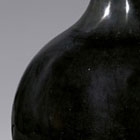J.J. Lally & Co., Oriental Art / New York City, New York
MenuPast Exhibition
Chinese Ceramics in Black and White
March 20–April 10, 2010
37.
A ‘MIRROR BLACK’-GLAZED PORCELAIN BOTTLE VASE
Kangxi Period (1662–1722)
with spherical body supported on a broad ring foot and surmounted by a slender cylindrical neck, covered overall with a rich glossy black glaze, the lip rim and recessed flat base glazed white.
Height 161⁄2 inches (42 cm)
A very similar black-glazed porcelain vase in the Victoria and Albert Museum is illustrated in Sekai tōji zenshū (Ceramic Art of the World), Vol. 15, Tokyo, 1983, p. 194, pl. 251. Another similar Kangxi black-glazed vase in the Asian Art Museum of San Francisco is illustrated by He Li, Chinese Ceramics: The New Standard Guide, London, 1996, p. 282, no. 553. Compare also the ‘mirror black’-glazed porcelain vase of this form illustrated by Ayers in The S. C. Ko Collection of Chinese Ceramics, Vol. I, Hong Kong, 1987, p. 163. Another ‘mirror black’-glazed bottle vase of this shape exhibited at the Ashmolean Museum, Oxford is illustrated in the catalogue of the London Oriental Ceramic Society exhibition, Iron in the Fire, London, 1988, p. 26, pl. 93.
The ‘mirror black’ glaze developed at Jingdezhen in the early 18th century is produced by combining oxides of iron and manganese with Chinese cobalt, creating a richer, more brilliant color than earlier Chinese black glazes derived from ferric oxide.
清康熙 烏金釉油錘瓶 高 42 厘米
